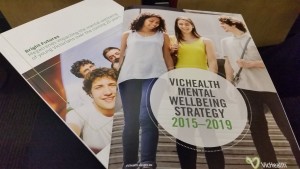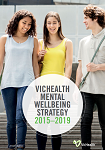VicHealth has today launched the new VicHealth Mental Wellbeing Strategy 2015–2019. The strategy builds on insights from a series of research evidence reviews commissioned by VicHealth and identifies that resilience is an important asset required for all young people to be successful into the future.
VicHealth’s priority focus for the next 3 years is to build resilience and social connection, with a particular focus on young people aged 12-25 years old. Resilience is about enhancing everyone’s ability to cope with, adapt to and bounce back from any change or challenge they experience in their lives. The capacity to be autonomous, regulate our emotions, have self-confidence and empathy, and be able to problem solve, are all resilience assets that the community as a whole should have. For young people, these skills and assets will be essential to navigate a rapidly changing economic, technological, social and global environment.
This short YouTube video explains what the new youth mental wellbeing strategy is all about.
Bright Futures: Megatrends impacting the mental wellbeing of young Victorians over the coming 20  years. A joint report between VicHealth and CSIRO, was concurrently launched. This report was commissioned to provide a clearer understanding of the challenges and opportunities ahead for young people in Victoria. As we know, youth is a critical period for social and emotional development. The report provides an analysis of new and emerging trends in society and their resulting influences on young people’s mental wellbeing.
years. A joint report between VicHealth and CSIRO, was concurrently launched. This report was commissioned to provide a clearer understanding of the challenges and opportunities ahead for young people in Victoria. As we know, youth is a critical period for social and emotional development. The report provides an analysis of new and emerging trends in society and their resulting influences on young people’s mental wellbeing.
The five ‘megatrends’ identified by VicHealth and CSIRO to be the strongest themes impacting the mental wellbeing:
- The rising bar: Rising skills and education levels in emerging economies, increased connectivity and automation, are leading to a more competitive global jobs market.
- Global reach: Globalisation and digital technology are changing the way workplaces and individuals operate. The future will see a new breed of portfolio workers who have no fixed abode and sell their skills and knowledge to multiple employers.
- Life’s richer tapestry: A more diverse culture, society and consumer market where identification of mainstream is increasingly difficult. This includes the aging population staying at work longer, increased growth in the Indigenous youth population and increase in number of non-traditional family structures such as single parent families.
- Overexposure online: Increasing exposure to wide-ranging online content, privacy breaches and virtual relationships. Young people will have virtual resumes which are beyond their control to edit as there will be an increase in the amount of discoverable personal information.
- Out of the shadows: Improved and widespread understanding of the causes of mental illness and building blocks for mental wellbeing, coupled with advances in medical technology and a change in service delivery models will help some. However, poor mental health in Indigenous and remote communities, and issues such as PTSD and family violence remain a major concern.
Together, these megatrends describe plausible futures for young people in Victoria. However, the report does not prescribe actions. Instead, some emerging questions are raised, which point to one overriding question: How can Victoria educate, prepare, and support young people so that they are ready to take on the challenges and benefit from the opportunities of the future?
To view VicHealth’s Mental Wellbeing Strategy 2015-2019 visit: https://www.vichealth.vic.gov.au/media-and-resources/publications/mental-wellbeing-plan
To view a copy of the VicHealth-CSIRO Megatrends Report visit: https://www.vichealth.vic.gov.au/megatrends
The Lancet Youth, would like to acknowledge the great work of our team members, Dr Nicola Reavley, Kristina Bennett and our Commission lead, Professor George Patton, played in writing two of the support reviews that contributed to the Mental Wellbeing Strategy.
Literature review: Epidemiological evidence relating to resilience and young people (PDF, 1.8MB)
Literature review: Interventions to build resilience among young people (PDF, 1.9MB)
